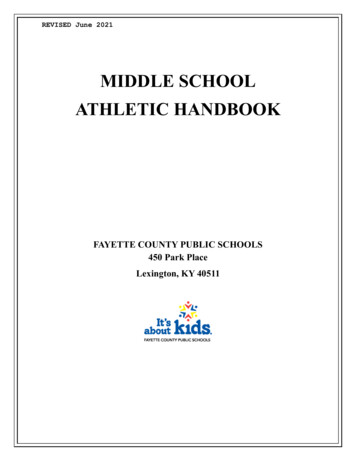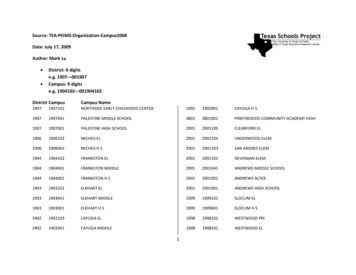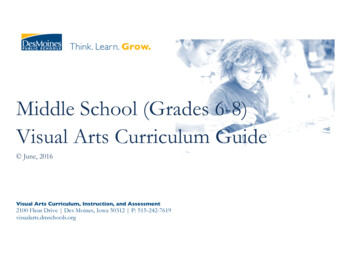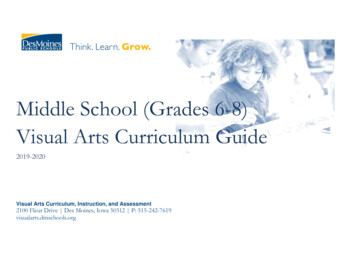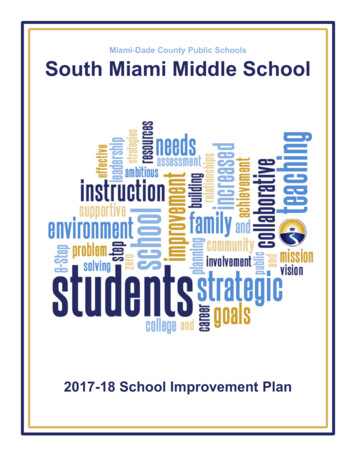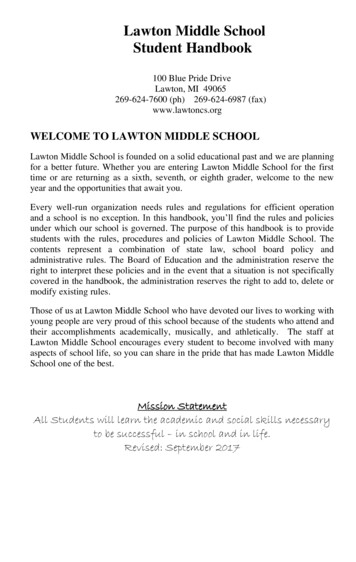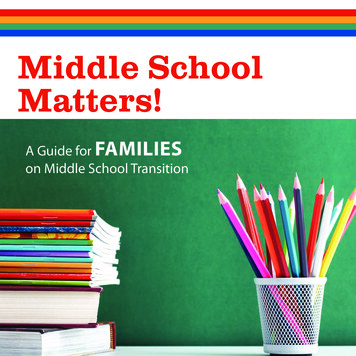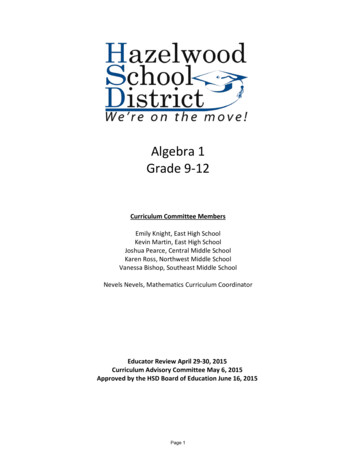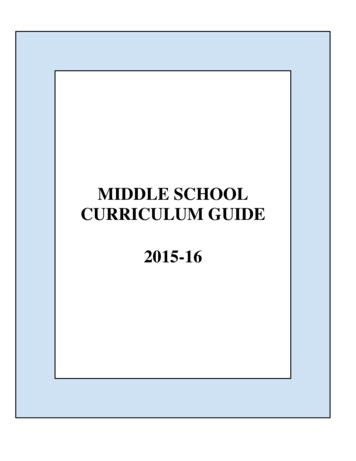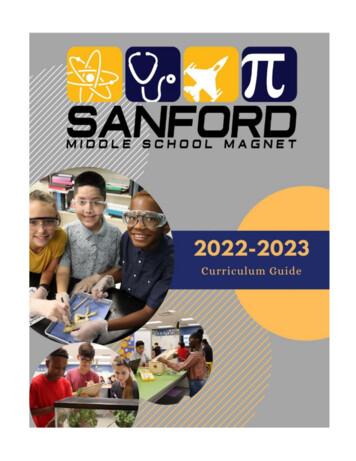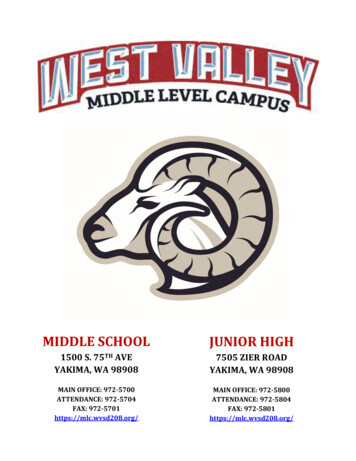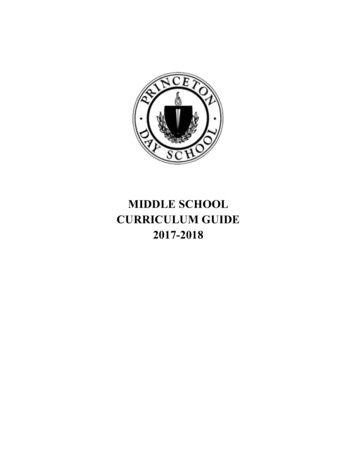
Transcription
MIDDLE SCHOOLCURRICULUM GUIDE2017-2018
As a member of the Princeton Day School community, I will pursue excellence inscholarship and character. I will try to be trustworthy, kind, honest, and fair; givemy best in and out of the classroom and on the playing field; be respectful ofmyself, of property, and of all members of our community; take responsibility formy actions; maintain a sense of humor.Welcome to the Middle School at Princeton Day School, a lively and engaging place for studentsin grades 5 through 8. Our goal is to create a culture where students feel safe, valued, celebratedand known.The quote above is on a plaque in the Middle School, and it truly captures what we strive forhere at Princeton Day School. In the Middle School at PDS, we encourage our students to beinvolved in activities both in and out of the classroom. We encourage them to take risks andvalue their own voice in the classroom. We believe in giving students opportunities to makemistakes, and then learn from them in a caring and supportive environment. In addition, we placegreat emphasis on keeping a growth mindset. We want students to view effort as the key tosuccess; to keep focused on continued—life-long—growth; and to keep trying even though theymay experience setbacks.Class sizes are kept small, and teachers, students, and parents work very closely together.Dedicated and talented faculty foster clear, thoughtful communication between home and school,forming a partnership that values educational excellence.At Princeton Day School, we teach skills and knowledge, but also, more critically, we teach ourstudents how to think and learn. Our Middle School teachers serve as role models and instill lifeskills, such as character, teamwork, creativity, ethics, resilience, curiosity, time management—all that is needed for a successful school career and, ultimately, a fulfilling life.Please explore these pages and contact us if you have any questions. We would be delighted tospeak to you and tell you more about the Middle School at Princeton Day School.Sincerely,Renée Charity PriceHead of Middle School1
Highlights of the Middle School Program:Advisory Program: The Middle School advisory program nurtures students during thetransformative time of early adolescence by providing them the tools necessary to ethicallynavigate and balance the diverse emotional, social, and academic worlds in which they live.Every student is matched with a faculty member who becomes their advisor for one school year.The advisee to advisor ratio is approximately 8:1. Students meet with their advisor and otherstudents in their advisory group every morning and also in longer advisory sessions wherecharacter, balancing academics and extracurricular activities, stress management and other topicsare explored. Advisors are a source of guidance and support and an excellent contact for parents.Focus Assembly: Once each 7-day cycle, the entire Middle School gathers for a FocusAssembly featuring several 8th Grade students who deliver a Focus Speech about an importantpersonal experience. From 5th grade on, students know that one day, they’ll have their turn. Thestudents work closely with their English teacher and advisor to develop ideas and deliver poised,and often moving, speeches that bring the community together. Parents and family membersoften attend to hear these remarks. Announcements and also occur at Focus so students stayinformed, and Focus Notes are emailed to families so they can talk to their children about MiddleSchool happenings.Athletics: Our Middle School program promotes participation, providing interested students aninterscholastic sports program appropriate for sixth, seventh and eighth graders. Our goals are toteach fundamental skills and strategies, develop a sense of team and to foster responsibility andcommitment.FallGirls: Cross Country, Field Hockey, Tennis, SoccerBoys: Cross Country, Soccer, Football (Middle School only)WinterGirls: Basketball, Volleyball, Ice Hockey, Fencing, SquashBoys: Basketball, Ice Hockey, Fencing, SquashSpringGirls: Lacrosse, Softball, Skating, Track & Field (Middle School only)Boys: Lacrosse, Baseball, Tennis, Skating, Track & Field (Middle School only)Mini-Course Week: Every year in mid-February, daily course work is set aside for a special,one-week interdisciplinary experience. Students choose from a menu of cultural, scientific, andhistorical studies with courses such as the Amish Experience, Gettysburg, Chocolate Immersion,2
New York, New York, and Top Chef. They spend the week in focused, experiential study,visiting museums, farms, research institutes, and historical parks to learn firsthand about theirsubjects. Mini-Course Week is a signature Middle School program.Da Vinci Program: The Da Vinci Program is a new and innovative program with courses on awide range of subjects, including robotics, sustainability, coding, and service learning, that aimsto engage students as the captains of their own learning. Each Middle School student will takecourses that they choose in which they take risks, explore individual passions, develop newinterests, and use multiple disciplines to solve problems and create original solutions.Bridges: The Bridges Program prepares our seventh graders for a successful and balancedexperience transitioning from childhood to adolescence and young adulthood. By providingguidance and mentorship from trained student leaders from the senior class, middle schoolerswill make connections, establish relationships and will be able to observe from their older peerleaders those behaviors that we believe to be important in the cultivation of the whole student.As another aspect to the global health and wellness curriculum at the Princeton Day School, theBridges program provides a safe and non-judgmental venue for discussion of topics important toyouth today. It will serve as a platform for discussing such topics as: personal character, socialresponsibility and good decision making through the context of school community, social norms,family dynamics, peer pressure, the internet and social media, sexuality, relationships andsubstance abuse.Bridges teams will meet during the DaVinci period on Day 4 from September 2017 until the endof March 2018.Activities: Students can choose from a range of additional activities such as Robotics, Chess,Food and Garden Club, Spelling & Geography Bees, Jazz Band, the 8th Grade Yearbook.Community Service: Middle School has a community service focus, and recent partnershipshave included children and education, hunger, and the elderly. Advisors work with students todesign meaningful experiences for students every year. Some recent projects have includedleading food drives, and reading to children at Homefront; creating “Kissing Pillows” for servicemen and women overseas; learning about and supporting the prevention of childhood diseases,such as leukemia and juvenile diabetes; and helping Lower School students in the PDScommunity.3
Middle School Curriculum:Health & Wellness:The Middle School Health and Wellness program seeks to empower our students to successfullynavigate the ever-changing environment we live in by promoting a healthy physical, mental, andsocial lifestyle. Students in each grade level study a developmentally appropriate curriculum.The curriculum revolves around a number of core topics: stress and study skills, sexuality,substance use and abuse, social media, and sustainability.Health educators, mental health personnel, and fitness, yoga, and movement instructors willwork in conjunction with speakers from our greater community to share important information intheir areas of expertise. The multimodal curriculum includes subjects such as the environment,nutrition, and safety. It is our hope that providing students with this developmentally appropriateand clinically pertinent learning will inform their decision-making and provide the skills theyneed to build a productive and healthy foundation for living.Physical Education:Fifth GradeAll 5th grade students participate in a comprehensive physical education program five classesout of each seven-day cycle. The goals of the program are: to encourage physical activitythrough the introduction of individual sports, team sports and skating; to improve eachindividual’s overall fitness level; and to a have fun while encouraging cooperation and goodsportsmanship.Sixth to Eighth GradeThe sixth through eighth grade physical education program is offered each season, and studentsparticipate in the course during the PE/Athletics period of the school day. Students engage in avariety of physical activities throughout the season that meet the needs of a range of skill andfitness levels. Key components of the program include individual and team sports, cooperativegames, and fitness training.Humanities:Fifth GradeStudents examine the organizing question "What are the elements of culture?" by creating uniquecultures in each Humanities class. These become part of a project-based archaeology experiencein which students excavate and analyze the representative artifacts of each class's culture. Thisfirst hand understanding is used to examine the civilizations of China, Greece and Rome,continually comparing different cultures and searching for themes that connect the modern worldto our ancient studies. Students are equally encouraged to experiment with multiple genres ofwriting, both as readers and writers.4
Sixth GradeStudents examine world history from the fall of Roman civilization through Medieval Islam tothe Renaissance. The organizing questions of the class are: "How do people interact with theirenvironment?" and "How do people communicate their ideas and beliefs?" Students comparecultures and civilizations and analyze their influence upon contemporary ideas, customs, beliefsand institutions. They are also encouraged to experiment with multiple genres of writing, both asreaders and writers.English:Students in grades 7 and 8 work to strengthen reading, writing, and public-speaking skills. Inaddition, students engage in regular grammar and vocabulary building activities. Each course isbuilt around an essential question.In seventh-grade students ask: “How do stories affect and change us?” The short storycollections Introducing the Short Story, Crazy Loco, Thirteen, extensive poetry units, astorytelling program, and a year-end public speaking unit provide rich and engagingopportunities for students to find answers.Eighth grade students ask: “How does literature help us understand ourselves and others?”Through the texts Twice Toward Justice, Of Mice and Men, To Kill a Mockingbird, and LittleWorlds (short stories) students are challenged to examine their own world in relation to theexperiences of others.Key Goals and Strategies:Literature Assessment Daily discussion (both whole-class and small-group) to examine aspects of literature:plot, setting, character, symbolism, irony, theme, etc. Quizzes on reading A variety of written responses to texts: analytical essay, journal response, fictional story,personal essay Written responses to independent reading each term Focus on independent thinking, making connections between texts and life, notetaking,listening and discussion skills Regular opportunity for revision of written workWriting Goals Develop ability to communicate effectively in essays, poetry, narrative, etc. Develop ability to respond thoughtfully in writing to literature and life situations Refine and deepen use of sophisticated writing techniques: analogies, figurative5
language, vivid imagery, etc. Opportunities to publish writing in literary contests outside of school curriculumWriting Genres Formal writing to include original short story, poetry, memoir, expository essay, andpersonal essay Emphasis on writing process: drafts, conferences, revision and editing Informal writing in response to or preparation for reading and discussion Writer’s Notebook: reflective pieces, “seed” pieces for development, responses toliterature, connections to own experiencesPoetry Integrated into literature units Developing sophistication of figurative language: metaphor, images, etc. Refinement of listening skills through frequent reading aloud of student poems Student poetry lessons throughout the year, based on the PDS Garden, outdoor spaces,and Imagine the Possibilities poets Publication of poems from all students in WHIMS, the PDS Middle School writingmagazineSpeech Frequent reading aloud in class, enactment of drama and narrative when appropriate Oral presentations with emphasis on speaking and presentation skills Increasing sophistication in class discussion skills and analysis Extensive storytelling and public-speaking instruction and practice in grade 7Vocabulary Literature-based lists with quizzes to assess knowledge of meaning, spelling, usage Graphic organizers to increase connections to specific words Literature terminology: plot, character, conflict, theme, climax, denouement, irony, etc. Revision of written work for accurate, appropriate vocabularyMechanics Spellingo Literature-generated lists; spelling rules reviewed, strategies implemented asneeded Grammaro Goal of transferring underpinnings of grammar and structure to aid in writing;mechanics assessment of each writing pieceo Review of parts of speech and structure of sentenceso Periodic quizzes: parts of speech, parts of sentence6
History:This two-year course examines the history of the United States with the purpose of teachingstudents the historical narrative, perceptions of national identity, and the importance of a citizen'srole in a democratic society. Academic skills taught are: close reading, historical research,analysis and evaluation of evidence, thesis-based writing, and oral presentation and argument.Life skills emphasized are: collaboration, empathy, development of a growth mindset, andexecutive function (planning, organizing, responsibility).In Grade Seven the content encompasses the growth of the US from European explorationthrough Reconstruction.In Grade Eight we examine the US during the 20th century, and supplement our study with anexamination of the rise of totalitarianism and its impact upon society.Mathematics:For more information on our math course pathways for students in grades 5-12, please see ourwebsite, under curriculum.Fifth GradeThe emphasis of the fifth grade course is on numerical reasoning, where whole number, decimal,and fraction concepts and computations are learned. In preparation for the following year’s prealgebra course, students are introduced to the order of operations, simple equation-solving, andthe use of variables. Measurement and geometry are also studied as students find the area andperimeter various polygons. Throughout the course, problem-solving strategies are expanded andpracticed and the students frequently apply ideas of mathematics to the science program.Resources: Prentice Hall Mathematics Course 1 Supplemental materials for enrichment State and national mathematics competitionsKey Goals for Students: To review and increase mastery of arithmetic processes using whole numbers, decimals,and fractions To receive an introduction to basic geometric ideas and employ measurement skills To build a background of information and experiences to prepare for future math study To improve math literacy To develop confidence and proficiency applying effective problem solving strategies7
Sixth GradePre-Algebra 6The sixth grade Pre-Algebra program introduces topics that lay the groundwork for futurealgebraic studies as well as revisiting topics seen in previous years of math class with more depthand sophistication. Students focus more on algebraic and geometric modeling as well as learnmore advanced computation with negative numbers and powers. Our program successfullyprepares students to start their formal study of Algebra in 7th grade, at which time all studentsbegin a two-year program and complete Algebra 1 by the end of 8th grade. Our goal is to providea rich experience that provides our students the best opportunity to gain a strong understandingof and appreciation for the material. We will cover a wide range of topics including: positiveand negative numbers, basic solving equations, number theory, rational numbers, ratio andproportion, percents, and two and three dimensional geometry.Resources: Prentice Hall Mathematics Course 2 Supplemental materials for enrichment State and national mathematics competitions Honors: Discovering Mathematics; Singapore Math ProgramKey Goals for Students: To gain useful familiarity with vocabulary and concepts of algebraic and proportionalreasoning To review and increase mastery of arithmetic processes using fractions, decimals, andintegers To experience a substantial preview of geometric ideas and apply equation-solvingtechniques to geometric objects in two and three dimensions To build a background of information and experiences to prepare for future math study To gain an understanding and appreciation of math’s place in the world by constant wordproblems and teaching methods designed to see how the numbers play out in real worldsituations To use the calculator appropriatelySeventh and Eighth GradeAlgebraThis comprehensive two-year Algebra I course covers all the traditional Algebra I topics indepth and is supplemented by special units, developed by PDS faculty, which extend and enrichthese topics and which provide a challenging review of arithmetic processes. Extending theAlgebra 1 course time frame to two years enables the students to engage in mathematically richinvestigations to build deep understandings and ensures that topics are aligned appropriately to8
the student’s cognitive development. The result is a richer course of study in Algebra and a levelof understanding that has served our students well as they have progressed in the study of higherlevels of math and science.Resources: Algebra 1, Holt McDougal Graphing calculators Supplemental materials for enrichment and review State and national mathematics competitions Honors: Algebra 1: McGraw-HillKey Goals for Students To gain a thorough understanding and mastery of the processes for solving and modelingsolutions of linear and quadratic sentences (equations and inequalities) and systems ofsentences To gain an appreciation of the relevance and importance of algebra in the real world andlearn how and when to apply algebraic skills to investigate real-life situations To use graphing calculators appropriately To gain familiarity and basic manipulative skills with matrices, exponential expressionsand equations, polynomials, functions, and quadratic and rational equations To build a background of information and experiences to prepare for future study in theareas of Geometry, Calculus and Statistics To review and extend skills with arithmetic processesComputer:Fifth and Sixth GradeThe Middle School has a 1:1 iPad program that is integrated throughout all classes in the division(for more information, please see our webpage on the iPad program in the Middle School). Forthis course, basic hardware operations and software skills are emphasized. Classes promotecreative writing using word processing software, and problem solving using data-analysissoftware. Students also investigate research and networking options via the Internet.Seventh Grade: STEM & FlightIn this course, students research, design, analyze, and simulate the forces of aerodynamics forflight in both virtual and physical environments. Through a virtual 3-D modeling process,students learn the critically important science, technology, engineering and math that lives justbelow the surface of creating an object capable of flight. Finally, students build the actual glidersthey simulated virtually, thereby "connecting the virtual to the physical" and completing the fullengineering design process. The course culminates in an exciting exhibition air show.9
Eighth Grade: Graphic & Web Page DesignIn this course, students will take up the challenge of the graphic designer to create a web site thatcommunicates ideas clearly, reflects aesthetic values, and provides the viewer with an interactiveexperience unique to the web medium. The techniques and value of incorporating audio, video,and animation into web pages will be explored.Science:Fifth GradeStudents investigate a wide range of topics in our laboratory-based program, learning the basictenets of the scientific method: skillful observation, devising accurate tests, recording data andmaking inferences. Course content includes earth history, evolution, electricity, magnetism,measurement and rocketry.Sixth GradeLife Science: Sixth graders continue using the scientific method in hands-on lab activities.Problem-solving investigations are performed in cooperative teams. Course content includesmicroscopy, cells, human body systems and plants.Seventh GradeEarth Science: Seventh graders learn to look at the earth as a dynamic system. Course contentincludes astronomy, geology, natural disasters, oceanography, meteorology and the origin andevolution of the universe.Eighth GradePhysical Science: Eighth graders are introduced to physical chemistry. This is primarily alaboratory course; concepts are reinforced through experimental work. Course content includeschemical concepts, the Law of Conservation of Mass, characteristic properties and the particulatemodel of matter.Sustainability:The PDS 6th grade Sustainability course begins by imbuing students with an appreciation of, andhopefully a love for, the natural world, in the belief that this is the first step towards becoming itsstewards. Students explore our local world, the PDS campus, unlocking some of the moreintriguing relationships among species at different times of year. Thus rooted, studentsinvestigate the roles that we as humans play in the natural world, with a focus on how we mightuse our understanding of the dynamic web of species and natural processes to at least mitigatenegative impacts and possibly foster positive interactions towards a sustainable future for not justour species, but as many as possible.Languages:10
Foreign language study broadens and intensifies in middle school. Fifth graders study eitherFrench or Spanish. In 6th grade, students continue to study French or Spanish, and they are alsointroduced to Latin during the first four weeks of school. The goal is twofold: to reinforce theircommand of grammar through the presentation of basic concepts of Latin grammar (which willbe useful for their grammar acquisition is English, French or Spanish); and to introduce them to alanguage that they can choose to study full time in 7th grade. In seventh and eighth grade,students focus on one language exclusively, studying Latin, French or Spanish. Each year thelanguage department successfully integrates students new to PDS at each grade level.Spanish 1The course begins with a quick introduction to the most basic aspects of the Spanish language.We read a short story that introduces new grammar and vocabulary within each unit. Studentsstudy sentence structure and learn how verbs are conjugated in Spanish. One of the main goalsfor level one is for the students to reach a mastery of the present tense. Additionally, studentsbecome proficient with irregular stem changing verbs and are introduced to the presentprogressive and present perfect tenses. In level one Spanish there is an emphasis on Spanishculture and students learn about various aspects of daily life in Spain. Level one is an immersionbased course, meaning there is little to no use of English. Towards the end of the year studentsshould be moderately conversational.Spanish 2This level focuses on the culture of Mexico. Reading skills are developed via guided readings oflegends with the goal of reaching an ever-increasing degree of independent or paired reading.The texts recycle prior vocabulary while also introducing new words. Oral skills are developedin the context of responses to the readings, the presentation of scripted versions of legends andthe performance of student-generated dialogues. Writing skills are developed in the context ofresponses to written texts and in retellings of stories we have read. Listening comprehensiondevelops as a result of instruction primarily in Spanish. Mastery of the interrogatives is stressedso that participants can have question and answer exchanges that flow in a variety of directions;teacher to student, student to student and student to teacher. Grammar topics emphasizeidentifying parts of speech, the formality and plurality of subject pronouns, continued practice ofpresent tense and present perfect verb conjugations, the formation of commands and theidentification and use of direct, indirect, reflexive and reciprocal pronouns.Spanish 3Spanish 3 is an immersion course that recycles the material learned in Spanish 1 and 2, whileintroducing new grammatical structures through the study of the clash of cultures between the“old” (Spain) and “new” (Central and South America) worlds. In class, we build upon the fourbasic skills (speaking, listening, writing and reading) of the previous courses, and move on tomid-proficiency level in these areas. Students are expected to stay in the target language and are11
introduced to the preterit and imperfect tenses. Core culture and civilization of the Spanishspeaking world are essential components of this course: we watch videos, listen to and learnsongs, and study Hispanic history and geography. Making connections between our lifeexperiences and the Spanish-speaking world is also an important component of the course.Group and pair work in the classroom is essential to acquire new concepts and improve oralskills.Spanish 4The highest level of Spanish in our Middle School starts with a quick review of the maingrammar points and verb tenses studied in previous years: present, reflexive verbs, commands,present perfect, preterit and imperfect. The class is conducted entirely in Spanish, and studentsare expected to stay in the target language for the entire class period as they continue to developtheir language skills through research, oral presentations, readings, story writing, documentaries,music, and even a soap opera! All the used oral and written materials are authentic and guidestudents through an exploration of important cultural topics relevant to the Hispanic world. Thefuture and the conditional tenses, as well as an introduction to the subjunctive mood, arepresented in this course and applied in meaningful contexts. Placement for the Upper School isdone in the spring and depends on each student's command of the language.French 1Students learn to communicate using everyday vocabulary, elementary grammar and basicsyntax. Through individual, paired and group exercises, we encourage students to expressthemselves in typical situations and everyday activities. Students are involved in meaningfulinteractions from the start. Topics include, among others: everyday classroom interaction, thefamily, pastimes and telling time. Students learn conjugation in the present tense with regular aswell as irregular verbs, concept of noun gender, and adjective agreement. Since culture is anessential component of the curriculum, students are exposed to short readings and activitiesinfused with cultural aspects of both the French and Francophone worlds.French 2At this level, students continue to expand their knowledge of vocabulary, verbs tenses (such asthe future tense futur proche and a quick introduction to the past tense passé composé with avoir)and moods (such as the imperative), and general communication. Topics include, among others:school schedules, pastimes, places, the weather and food. The emphasis is on advancing andintegrating listening, speaking, reading, and writing skills. Students read a short story to enrichthe full immersion in the French language. Projects are also a part of the curriculum, used to linkstudents' interests with aspects of contemporary French and francophone cultures. A film andsongs reinforce essential vocabulary, cultural knowledge and listening comprehension.12
French 3At this level students continue to expand their knowledge of vocabulary, grammatical structuresof intermediate difficulty (such as the past tense passé composé with être and avoir, expressingquantity and using partitive articles), and general communication. The emphasis is on advancingand integrating listening, speaking, reading, and writing skills. Students read short authentic textsand are asked to perform skits and songs. Projects are also a part of the curriculum, used to linkstudents' interests with aspects of contemporary French and francophone cultures and to practiceresearching information online. Films, songs, and other media reinforce vocabulary, linguisticstructures, cultural knowledge, and listening comprehension.French 4At this level students continue to expand their knowledge of vocabulary, grammatical structuresof intermediate difficulty: conjugation and usage of the two past tenses imparfait and passécomposé, object pronouns, reflexive and pronominal verbs, comparative and superlativeadjectives, and general communication. The emphasis is on advancing and integrating listening,speaking, reading, and writing skills. Students read more authentic texts, and are asked to writenarratives with past tenses and speak extemporaneously. Projects and media are used as inFrench 3 but at higher levels of sophistication. French 4 allows students to prepare for atransition into Upper School French II or III. Placement for the Upper School is done in thespring and depends on each student's command of the language.6th grade – Latin ComponentStudents are introduced to the basic foundations of Latin as they spend some time makingconnections to their chosen Romance language. Students also get a tast
Middle School Curriculum: Health & Wellness: The Middle School Health and Wellness program seeks to empower our students to successfully navigate the ever-changing environment we live in by promoting a healthy physical, mental, and social lifestyle. Students in each grade level study a developmentally appropriate curriculum.
